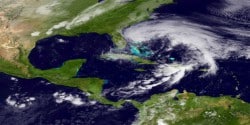by Dene Moore (Postmedia News)

VANCOUVER – A small British Columbia First Nation making waves around the world with a controversial experiment in the Pacific Ocean is on the front lines of climate change, even critics admit.
And as the fears of global warming grow, there is a risk that potentially dangerous geoengineering experiments like the ocean fertilization carried out off the islands of Haida Gwaii will be unleashed as a quick fix, warns Jim Thomas, spokesman for Montreal-based ETC Group, a geoengineering watchdog.
“In desperate times desperate people do sometimes rather stupid things,” said Thomas.
A spokesman for the Haida Salmon Restoration Corp., which arranged funding for and carried out the experiment, said the organization is no longer doing media interviews about the issue.
John Disney, head of the salmon restoration corporation and economic development officer for Old Massett, said the corporation’s intentions have been misinterpreted, and the experience has been very trying.
“You have to understand that caught up in some big international … whatever, this little Haida community has had their whole integrity and their character totally assassinated,” Disney said.
The Haida people have relied for centuries on the world around them for survival, in particular on the salmon. The fish play a central role in not only the Haida diet, but the culture of Haida Gwaii, an archipelago 80 km off the northwest coast of B.C., that is home to a UNESCO world heritage site.
Like fishermen throughout B.C., they watched salmon stocks decline for decades until a near collapse in 2009. That year, the largest run in the province — the Fraser River run — plummeted to 1.7 million fish. The federal government announced a public inquiry, but many felt it was too late to save the run.
Then the following year, returns defied all predictions. Rivers ran red with the backs of spawning salmon as the Fraser River run hit 34 million.
There is no shortage of scientific speculation that a 2008 volcanic eruption on the Aleutian Islands of Alaska, which spewed iron-laden ash over thousands of kilometres of the North Pacific, was the cause for the large return.
A 2010 study of the Mount Kasatoshi volcano by Institute of Ocean Sciences, within the federal Fisheries and Oceans Ministry, concluded that the ash was a contributing factor.
“…the volcanic emission of iron-rich dust in 2008 caused a massive late summer bloom of diatoms that enhanced the food chain for young sockeye salmon in the Gulf shortly after they migrated into the oceanic habitat,” it said, though the ash was not exclusively responsible.
And it was not the first time. In 1956, the study noted, a volcanic eruption in Kamchatka, Russia, was believed to cause a sockeye run 20 million-strong in 1958.
“This is about the fish,” Ken Rea, chief councillor for the village of Old Massett, said when news first broke of the experiment. “This is about providing sustainable opportunities for our future generations.”
Over several days in late July, from a leased fishing vessel called the Ocean Pearl, almost 200 metric tons of iron dust, iron sulfate fertilizer and iron oxide were dumped over an area of about one square kilometre 300 kilometres west of Haida Gwaii, just outside Canadian territorial waters.
Satellite images suggest the fertilization resulted in a 10,000-square kilometre plankton bloom. The Haida will have to wait two years to see if they achieved the desired effect on salmon returns.
But if the village of Old Massett entered into the experiment in an effort to restore salmon, critics aren’t saying the same of its partner in the project.
Russ George is listed as the CEO and chief scientist of Planktos Inc., a defunct company dedicated to “carbon remediation and creative eco-restoration.” George has made several attempts to sell carbon credits for ocean fertilization.
“This is a village project. They started it, they own it, they run it. It’s not the Russ George rogue geoengineering story,” George told Scientific American magazine this week.
“You’ve seen the vile and vehement twisting of this story. You can probably imagine how I feel. (It) was the faith and trust and hopes and dreams of a village whose environment is dying, whose culture is dying because the salmon are dying. And now the world is saying they were duped.”
George is pursuing the Holy Grail of environmental entrepreneurship: a profitable process to address the current global climate crisis.
A phytoplankton bloom does capture carbon, trapping it at the bottom of the ocean as the organisms that feed off the algae die and sink. Previous, smaller-scale tests show the effect was short-term.
“It’s not divided,” said Roberta Hamme, an oceanographer at the School of Earth and Ocean Sciences at the University of Victoria who studied the fallout from the 2008 volcanic eruption in Alaska.
“Almost every experiment has said that it’s not an efficient way. You can take up some carbon, but it’s not an efficient way to go about it and, if it were done on a large scale, would likely have significant impacts on the ecosystem.”
George’s critics suggest long-term carbon capture is environmental snake oil.
“Our concerns are nested in wider concerns about geoengineering … We are concerned about any move towards deploying or testing geoengineering schemes,” said Thomas, of ETC, which stands for Erosion, Technology and Concentration.
“We’re concerned about what this means in terms of moving toward more geoengineering tests.”
International negotiations have failed to address climate change, he said, and there are people who “are reaching for these quick fix, very risky approaches such as geoengineering.”
As far as salmon restoration, Thomas said stakeholders should wait for the report expected later this year from the public inquiry into the 2009 collapse.
“The particular hypothesis that they were trying to examine is interesting but it’s not an excuse to try a large-scale ocean fertilization.”



